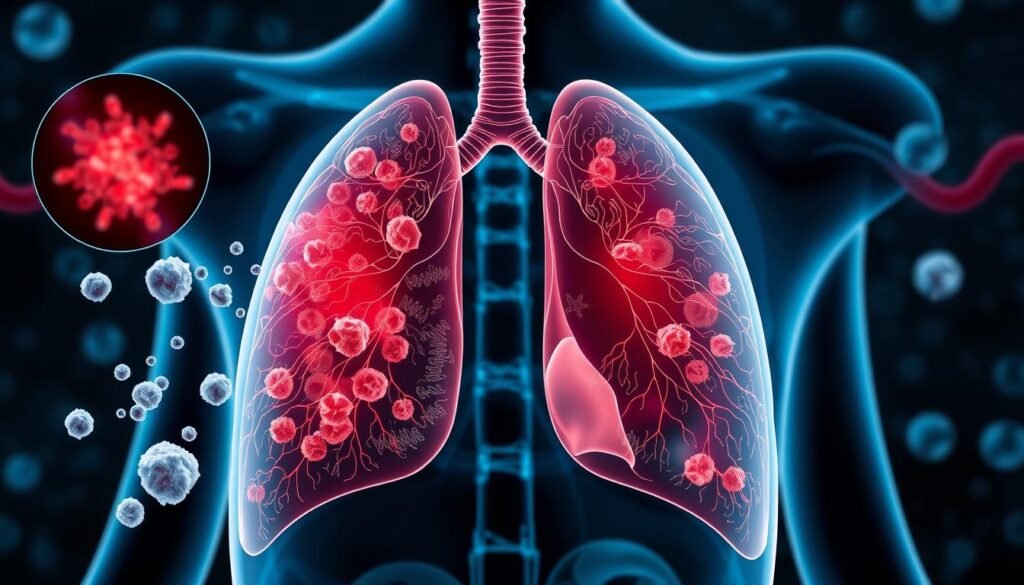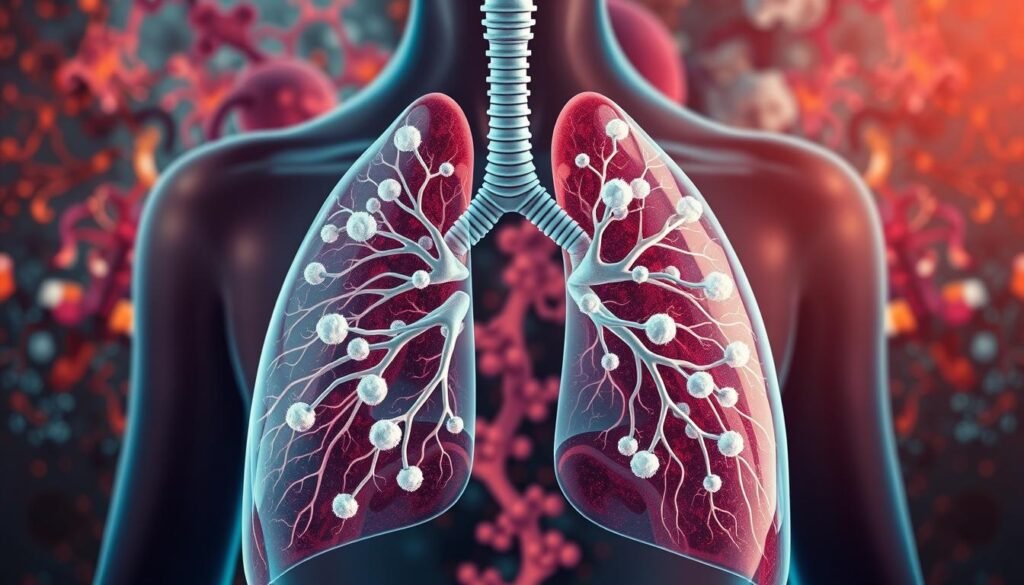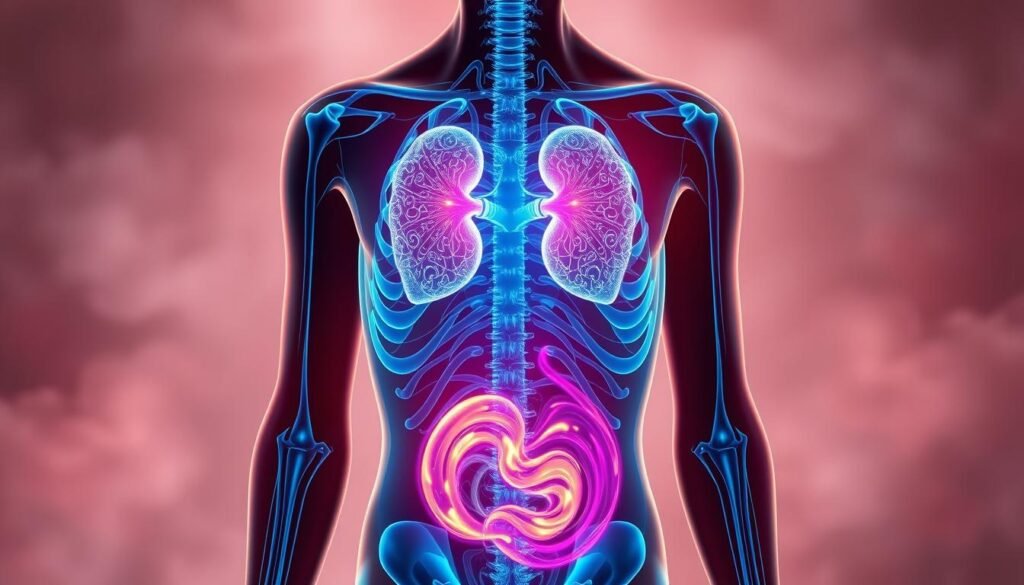It may come as a surprise, but about 1 in 3 people with cancer face high calcium levels. This condition is called hypercalcemia. It often shows that the cancer is advanced, which means a worse outlook and fewer treatment options. Lung cancer, along with breast and kidney cancers, commonly causes hypercalcemia. It’s important to understand how lung cancer and high calcium levels are connected. This helps doctors manage and treat patients better.
In this article, we’ll cover how lung cancer can lead to high calcium levels. We’ll talk about the symptoms, causes, how to diagnose it, and ways to treat it. This info helps you learn not just about hypercalcemia, but also its impact on lung cancer patients. For more details, you can read a thorough analysis here.
Key Takeaways
- Approximately 1 in 3 cancer patients experience hypercalcemia.
- Lung cancer is frequently linked to elevated calcium levels along with breast cancer and multiple myeloma.
- Multiple myeloma has an annual hypercalcemia occurrence rate between 7.5 to 10.2 percent.
- Prostate cancer exhibits the lowest rates of hypercalcemia, around 1.4 to 2.1 percent annually.
- Elevated calcium can significantly complicate treatment and prognosis in lung cancer patients.
- Early detection and management of hypercalcemia are vital for improving patient outcomes in oncology.
Introduction to Lung Cancer
Lung cancer is a leading cause of death from cancer worldwide. It mainly comes in two kinds: non-small cell lung cancer (NSCLC) and small cell lung cancer (SCLC). Each type acts differently and responds uniquely to treatment.
Finding lung cancer early is hard, often leading to late diagnosis. For example, if someone has a persistent cough or chest pain, they should see a doctor. Knowing these early signs can help avoid severe problems like hypercalcemia. This serious condition can affect 2.5% to 12.5% of lung cancer patients, showing its common link to the illness.
The survival rate for lung cancer patients with hypercalcemia is usually only one month after detection. Knowing what increases your lung cancer risk is vital. Smoking is the top risk, but the environment and genetics also play roles. This knowledge is key to fighting the disease.
To spot lung cancer early, be aware of symptoms like swollen neck lymph nodes. Tests and scans can catch it early, leading to better chances of beating it. Early detection makes a big difference, possibly changing the disease’s outcome.
Learn more about the signs linked to late-stage lung cancer, including the effects of hypercalcemia.
Understanding Hypercalcemia
Hypercalcemia is when the blood has too much calcium. It’s common in people with cancers like lung, breast, and multiple myeloma. The cause can be cancer eating away at bones or too much vitamin D production.
In folks with non-small cell lung cancer, hypercalcemia is not rare. Studies say about 12.2% of these patients have high calcium when diagnosed. Even with small cell lung cancer, which is less often linked to this issue, calcium can spike to 16.4 mg/dl.
The signs of high calcium range from mild to very bad. Look out for:
- Fatigue
- Nausea and vomiting
- Loss of appetite
- Constipation
- Muscle weakness
- Increased thirst
- Confusion
Without treatment, hypercalcemia could be deadly. It’s key to watch calcium levels in cancer patients to keep them safe.

To treat hypercalcemia, doctors often turn to hydration first. In tough cases, patients might need to be in the hospital for IV fluids. Drugs like bisphosphonates and Denosumab are also used to control it.
Knowing about hypercalcemia helps ensure patients get the right help. It’s a big part of caring for those with lung cancer and other serious illnesses.
Connection Between Lung Cancer and Hypercalcemia
Lung cancer and hypercalcemia have a deep link. Lung cancer is deadly. Up to 30% of cancers show hypercalcemia. This is often because of paraneoplastic syndromes. These are issues linked to cancer but not caused directly by the tumor. It’s key for lung cancer patients to know how these syndromes affect calcium in the body.
The Role of Paraneoplastic Syndromes
Paraneoplastic syndromes can make calcium levels in the blood go too high. This happens by releasing substances like parathyroid hormone-related peptide (PTHrP). These substances mess with the normal balance of calcium, leading to hypercalcemia. With lung cancer, these peptides cause about 80% of hypercalcemia cases. That’s why monitoring calcium levels in these patients is so important. You can learn more about lung cancer stages by checking out the TNM staging system.
Impact on Calcium Metabolism
It’s crucial to understand calcium metabolism in lung cancer patients. High calcium levels can harm the body and cause serious issues. Sometimes, too much calcitriol makes the problem worse. Although rare, it’s behind about 1% of these hypercalcemia cases. Symptoms can be mild or severe, depending on the calcium level. This shows why acting fast is needed.
One way to handle this is by looking at studies of lung cancer patients with hypercalcemia. There was a patient with squamous cell lung carcinoma. Their calcium levels went up and down with the disease’s progression. These situations underscore the importance of managing calcium levels well. Getting to know how cancer and calcium metabolism interact helps in caring for patients.

| Calcium Level Category | Calcium Level (mg/dL) | Typical Symptoms |
|---|---|---|
| Mild Hypercalcemia | 10.5 – 11.9 | Fatigue, nausea, mild confusion |
| Moderate Hypercalcemia | 12.0 – 13.9 | Increased thirst, frequent urination, weakness |
| Severe Hypercalcemia | ≥14.0 | Severe disorientation, kidney dysfunction, arrhythmias |
Symptoms of Hypercalcemia
It’s important to know the symptoms of hypercalcemia early. This helps manage complication management effectively. Many people with cancer might see these symptoms too. Knowing about them helps get the right treatment quickly.
Common Signs and Symptoms
Hypercalcemia starts with symptoms that are hard to notice. They may include:
- Fatigue – Feeling very tired even after resting.
- Weakness – Not having much energy or strength.
- Gastrointestinal disturbances – Issues like constipation and feeling sick.
These first signs mean calcium in the body is too high. People and their caregivers should watch for these signs. This helps get medical help early.
Advanced Symptoms and Complications
When hypercalcemia gets worse, the symptoms are more serious. They include:
- Seizures – Dangerous events that need quick action.
- Altered mental status – Such as confusion, not knowing where you are, or coma in severe cases.
High calcium for too long can cause big health problems. These include weak bones, kidney stones, and heart issues. Learning how serious hypercalcemia can be is critical. Even small problems can get worse fast. Find out how serious hypercalcemia is.

Cancer patients should check their calcium levels regularly. This is especially true for those at high risk. Dealing with hypercalcemia early helps prevent bigger problems. Thus, complete care and knowing the symptoms lead to better health for patients.
Causes of Hypercalcemia in Cancer Patients
Hypercalcemia is a big issue in cancer care. It affects patients with different kinds of cancers. Most of the time, it’s because of more bone breakdown from bone metastases. This problem raises calcium levels in the blood. It’s common in lung, breast, and multiple myeloma cancers.
Tumors can release something called PTHrP. This acts like parathyroid hormone, making calcium levels go up.
- Multiple myeloma has one of the highest risks of hypercalcemia. Studies show it happens in 7.5 percent to 10.2 percent of cases in the US.
- Osteoclastic activity, boosted by things like RANKL and MIP-1α from cancer cells, causes a lot of bone loss and high calcium.
Rarer cancers can cause hypercalcemia too. This includes neuroectodermal tumors and pancreatic cancers. Sometimes, the extra parathyroid hormone comes from unexpected places in tumors. This shows the wide range of cancer-related factors that affect calcium.
Treating hypercalcemia means getting calcium levels back to normal and easing symptoms. Options include fluids, bisphosphonates, calcitonin, and denosumab. Knowing all the causes of hypercalcemia helps health workers pick the right treatment. This article offers more details on treatment. It’s key to taking care of patients well.
| Malignancy Type | Percentage Risk of Hypercalcemia |
|---|---|
| Multiple Myeloma | 7.5% – 10.2% |
| Lung Cancer | High |
| Breast Cancer | High |
| Prostate Cancer | 1.4% – 2.1% |
| Colorectal Cancer | Low |
It’s critical to watch cancer patients closely and act fast. Understanding all the ways cancer can cause hypercalcemia is key. It helps in managing and treating patients effectively.
Lung Cancer Types Associated with Hypercalcemia
Lung cancer is closely linked with hypercalcemia. The two main types are non-small cell and small cell lung cancer. They have different ways of associating with this condition. Knowing these connections helps predict patient complications.
Non-Small Cell Lung Cancer
Non-small cell lung cancer is a main type linked with hypercalcemia. About 25% of those with squamous cell carcinoma may get cancer-induced hypercalcemia (CIH). At first diagnosis, 2-6% have it, which goes up to 8-12% as the disease gets worse. This usually happens because of a protein that raises calcium in the blood.
Small Cell Lung Cancer
Small cell lung cancer and hypercalcemia are less connected. Even with bone spread, hypercalcemia is rare. It can occur due to abnormal hormone release. Though only 10% of lung cancer cases are linked to such syndromes, it’s still important. It shows how lung cancer types affect calcium differently.
Diagnosis of Hypercalcemia in Lung Cancer Patients
To find out if lung cancer patients have hypercalcemia, doctors look at symptoms and run tests. Finding it early is key. Testing for blood calcium levels is how they know for sure. The right tests show how high the calcium is, which is critical.
Blood Tests and Calcium Levels
Blood tests are crucial for spotting hypercalcemia. They check for:
- Total calcium levels: Gives a snapshot of calcium in the blood.
- Ionized calcium levels: Shows the active calcium part.
- Albumin correction: Fixes total calcium results using albumin levels for accuracy.
Usually, calcium levels are around 2.65 mmol/L. If the numbers are off, doctors dig deeper, especially in cancer cases. High calcium can be a bad sign for them.
Radiological Assessments
Doctors also use scans to look for cancer reasons for high calcium. They use:
- X-rays
- CT scans
- Bone scans
These scans help spot bone issues or tumors. Finding these helps doctors plan the best treatment.
Linking calcium levels with cancer growth shows why good diagnosis methods matter. Doctors can then give the right care for lung cancer patients with hypercalcemia.
| Test Type | Description | Normal Range |
|---|---|---|
| Total Calcium Level | Measures overall calcium concentration in blood | 2.65 – 2.75 mmol/L |
| Ionized Calcium Level | Evaluates physiologically active calcium level | 1.1 – 1.3 mmol/L |
| Albumin Correction | Adjusts total calcium based on albumin levels | Depends on individual albumin levels |
By using blood tests and scans, doctors can identify and treat hypercalcemia in lung cancer patients. This helps improve how long they live and their quality of life.
Treatment Options for Hypercalcemia
Managing hypercalcemia in cancer patients needs a deep understanding of its causes. The most effective way to treat it is through treatment for hypercalcemia with intravenous hydration. This helps flush out the extra calcium and eases symptoms.
Keeping the right fluid balance is key to avoiding worsening the situation through dehydration.
Hydration and Supportive Care
Hydration is just the start. Supportive care is also critical for handling hypercalcemia symptoms. This includes checking kidney function and making sure the patient is comfortable.
Dealing with nausea, fatigue, or confusion from hypercalcemia takes several strategies. Care teams focus on bettering the patient’s overall health while tackling the base issue.
Medications and Interventions
Medicines are vital in treating hypercalcemia. Bisphosphonates and calcitonin are often used to control high calcium levels. These medications stop bones from breaking down and help the body get rid of calcium.
If these methods don’t work, dialysis might be used. It’s a quicker way to reduce calcium in severe cases.
For further info on issues like back pain in lung cancer, check out this resource: understanding back pain in lung cancer.